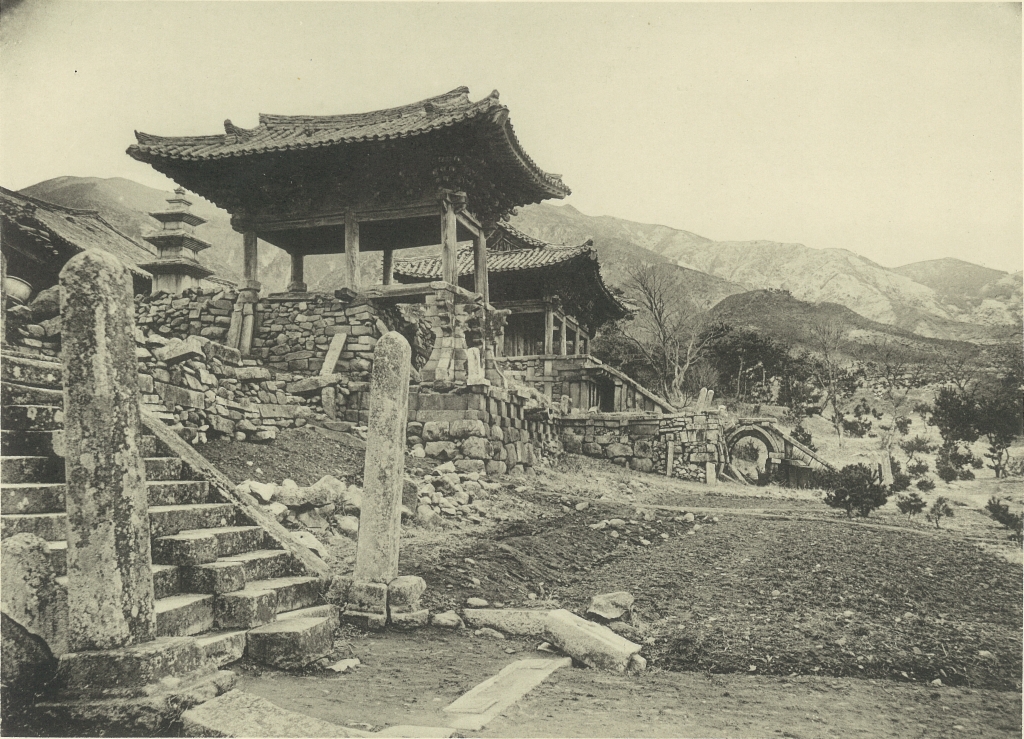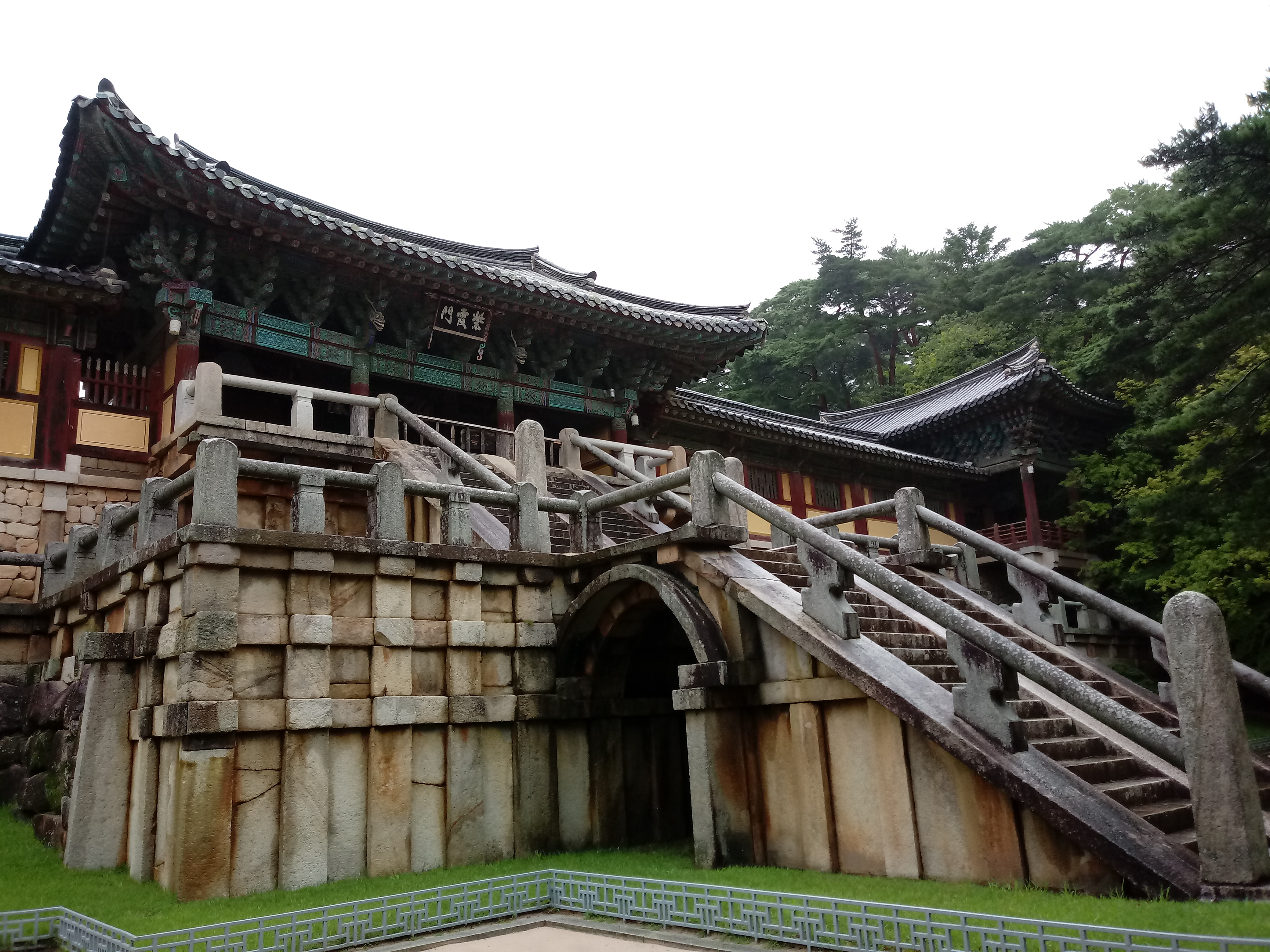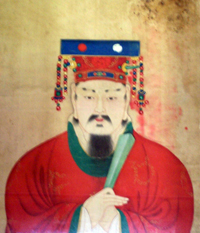|
Bulguksa
Bulguksa is located on the slopes of Mount Toham (Jinheon-dong, Gyeongju city, North Gyeongsang province, South Korea). It is a head temple of the Jogye Order of Korean Buddhism and encompasses six National treasures of South Korea, including the Dabotap and Seokgatap stone pagodas, Cheongun-gyo (Blue Cloud Bridge), and two gilt-bronze statues of Buddha. The temple is classified as ''Historic and Scenic Site No. 1'' by the South Korean government. In 1995, Bulguksa was added to the UNESCO World Heritage List together with the Seokguram Grotto, which lies four kilometers to the east. The temple is considered as a masterpiece of the golden age of Buddhist art in the Silla kingdom. It is currently the head temple of the 11th district of the Jogye Order of Korean Buddhism. Among the earliest woodblock prints in the world, a version of the Dharani sutra dated between 704 and 751 was found there in 1966. Its Buddhist text was printed on a mulberry paper scroll. History The temple's ... [...More Info...] [...Related Items...] OR: [Wikipedia] [Google] [Baidu] |
Bulguksa In 1914
Bulguksa is located on the slopes of Mount Toham (Jinheon-dong, Gyeongju city, North Gyeongsang province, South Korea). It is a head temple of the Jogye Order of Korean Buddhism and encompasses six National treasures of South Korea, including the Dabotap and Seokgatap stone pagodas, Cheongun-gyo (Blue Cloud Bridge), and two gilt-bronze statues of Buddha. The temple is classified as ''Historic and Scenic Site No. 1'' by the South Korean government. In 1995, Bulguksa was added to the UNESCO World Heritage List together with the Seokguram Grotto, which lies four kilometers to the east. The temple is considered as a masterpiece of the golden age of Buddhist art in the Silla kingdom. It is currently the head temple of the 11th district of the Jogye Order of Korean Buddhism. Among the earliest woodblock prints in the world, a version of the Dharani sutra dated between 704 and 751 was found there in 1966. Its Buddhist text was printed on a mulberry paper scroll. History The temple's ... [...More Info...] [...Related Items...] OR: [Wikipedia] [Google] [Baidu] |
National Treasures Of South Korea
A National Treasure () is a tangible treasure, artifact, site, or building which is recognized by the South Korean government as having exceptional artistic, cultural and historical value to the country. The title is one of the eight State-designated heritage classifications assigned by the Cultural Heritage Administration, administrator of the Cultural Heritage Administration (CHA) in accordance with the Cultural Heritage Protection Act after deliberation by the Cultural Heritage Committee. Many of the national treasures are popular tourist destinations such as Jongmyo (Seoul), Jongmyo royal ancestral shrine, Bulguksa, Seokguram, and Tripitaka Koreana at Haeinsa. As of May 2020, there are 327 distinct entries on the list, some composed of a large number of sub-entries. The treasures are numbered according to the order in which they were designated, not according to their individual value. The National Treasures are designated within the Heritage preservation in South Korea, herit ... [...More Info...] [...Related Items...] OR: [Wikipedia] [Google] [Baidu] |
Gyeongju
Gyeongju ( ko, 경주, ), historically known as ''Seorabeol'' ( ko, 서라벌, ), is a coastal city in the far southeastern corner of North Gyeongsang Province in South Korea. It is the second largest city by area in the province after Andong, covering with a population of 264,091 people (as of December 2012.) Gyeongju is southeast of Seoul, and east of Daegu. The city borders Cheongdo and Yeongcheon to the west, Ulsan to the south and Pohang to the north, while to the east lies the coast of the Sea of Japan. Numerous low mountains—outliers of the Taebaek range—are scattered around the city. Gyeongju was the capital of the ancient kingdom of Silla (57 BC – 935 AD), which ruled about two-thirds of the Korean Peninsula at its height between the 7th and 9th centuries, for close to one thousand years. Later Silla was a prosperous and wealthy country, and its metropolitan capital of Gyeongju was the fourth largest city in the world. A vast number of archaeological sites an ... [...More Info...] [...Related Items...] OR: [Wikipedia] [Google] [Baidu] |
Seokgatap Bulguksa
Seokgatap (Sakyamuni Pagoda) is a stone pagoda in South Korea designated as the 21st National Treasure on December 12, 1962. Its full name is ''Sakyamuni Yeoraesangjuseolbeop Tap'', and is sometimes referred to as the Shadowless Pagoda or the ''Bulguksa Samcheung Seoktap'' ("three-storied stone pagoda of Bulguksa"). The pagoda stands 10.75 meters high, directly across from Dabotap within the Bulguksa Temple complex in Gyeongju, South Korea. It probably dates to around 751, when Bulguksa was completed. Description The Seokgatap pagoda is in distinct contrast with its more elaborate brother the Dabotap. The pagoda is of a very simple and basic design and the three stories have a pleasing 4:3:2 ratio which gives the pagoda a sense of balance, stability, and symmetry. The contrast between the simplicity of the Seokgatap and the complexity of the Dabotap is designed to represent the dual nature of the Buddha's contemplation and detachment from the world or perhaps it symbolizes th ... [...More Info...] [...Related Items...] OR: [Wikipedia] [Google] [Baidu] |
Seokgatap
Seokgatap (Sakyamuni Pagoda) is a stone pagoda in South Korea designated as the 21st National treasures of South Korea, National Treasure on December 12, 1962. Its full name is ''Sakyamuni Yeoraesangjuseolbeop Tap'', and is sometimes referred to as the Shadowless Pagoda or the ''Bulguksa Samcheung Seoktap'' ("three-storied stone pagoda of Bulguksa"). The pagoda stands 10.75 meters high, directly across from Dabotap within the Bulguksa Temple complex in Gyeongju, South Korea. It probably dates to around 751, when Bulguksa was completed. Description The Seokgatap pagoda is in distinct contrast with its more elaborate brother the Dabotap. The pagoda is of a very simple and basic design and the three stories have a pleasing 4:3:2 ratio which gives the pagoda a sense of balance, stability, and symmetry. The contrast between the simplicity of the Seokgatap and the complexity of the Dabotap is designed to represent the dual nature of the Buddha's contemplation and detachment from the ... [...More Info...] [...Related Items...] OR: [Wikipedia] [Google] [Baidu] |
Seokguram
The Seokguram Grotto is a hermitage and part of the Bulguksa temple complex. It lies four kilometers east of the temple on Mt. Tohamsan, in Gyeongju, South Korea. It is classified as ''National Treasure No. 24'' by the South Korean government and is located at 994, Jinhyeon-dong, Gyeongju-si, Gyeongsanbuk-do. The grotto overlooks the Sea of Japan and rests 750 meters above sea level. In 1962, it was designated the 24th national treasure of Korea. In 1995, Seokguram was added to the UNESCO World Heritage List together with the Bulguksa Temple. It exemplifies some of the best Buddhist sculptures in the world. The Seokguram grotto is said to have been built by Kim Daeseong and originally called ''Seokbulsa'' (석불사, ''Stone Buddha Temple''). Construction began in 742 when Kim Daeseong resigned his position in the king's court or in 751, the 10th year of the reign of King Gyeongdeok of Silla. This time period was the cultural peak of Unified Silla. The grotto was completed b ... [...More Info...] [...Related Items...] OR: [Wikipedia] [Google] [Baidu] |
Dabotap
This refers to a pagoda containing the relics of Dabo Yeorae. Dabo Pagoda, also known as ''pagoda of many treasures'', is located in the temple of Bulguksa in Gyeongju, South Korea. From entering the temple through the Cheongun and Baegun Bridge, Dabotap is located on the right side, opposing Seokgatap on the left side. The pagoda is supposed to have been built in 751, the 10th year of the Shilla king Gyeongdeok. It is currently designated as National Treasure no. 20. The 3 story pagoda stands 10.29 metres tall and was built in an ornate style not seen in other Buddhist countries. The sculpture techniques used are unique for its time and include delicate features. It has a staircase on each of the four sides. Four stone square pillars support the pagoda's first roof, where is built a square stone railing. Inside the railing is the body of the pagoda, and above it, standing on the second octagonal-shaped roof surrounded by an octagonal stone railing, are eight bamboo-shaped stone ... [...More Info...] [...Related Items...] OR: [Wikipedia] [Google] [Baidu] |
Pagoda
A pagoda is an Asian tiered tower with multiple eaves common to Nepal, India, China, Japan, Korea, Myanmar, Vietnam, and other parts of Asia. Most pagodas were built to have a religious function, most often Buddhist but sometimes Taoist, and were often located in or near viharas. The pagoda traces its origins to the stupa of ancient India. Chinese pagodas () are a traditional part of Chinese architecture. In addition to religious use, since ancient times Chinese pagodas have been praised for the spectacular views they offer, and many classical poems attest to the joy of scaling pagodas. Chinese sources credit the Nepalese architect Araniko with introducing the pagoda to China. The oldest and tallest pagodas were built of wood, but most that survived were built of brick or stone. Some pagodas are solid with no interior. Hollow pagodas have no higher floors or rooms, but the interior often contains an altar or a smaller pagoda, as well as a series of staircases for the vis ... [...More Info...] [...Related Items...] OR: [Wikipedia] [Google] [Baidu] |
Gyeongdeok Of Silla
Gyeongdeok of Silla (景德王; 742–765) was the 35th ruler of Silla and son of King Seongdeok (reigned 702–737). He succeeded his elder brother, King Hyoseong, the 34th ruler of Silla. His reign is considered a golden age in Unified Silla’s history, particularly for Buddhist art and architecture. He is noted as an intent patron of Buddhism and an influential political and religious individual. King Gyeongdeok also made attempts to centralize the country through reorganizing government and standardizing naming practices. With his mother as regent, Gyeongdeok’s son, King Hyegong, succeeded him after his death. Family * Grandfather Sinmun of Silla (r. 681–692) (김정명) * Grandmother: Queen Sinmok of the Kim clan (신목왕후 김씨;d. 700) * Father: Seongdeok of Silla (reigned 702–737) (성덕왕) * Mother: Queen Sodeok (소덕왕후 김씨), of the Kim clan * Wife: ** Queen Sanmono, of the Kim clan (삼모부인 김씨), daughter of Kim Sun–jeong (김순정) ... [...More Info...] [...Related Items...] OR: [Wikipedia] [Google] [Baidu] |
South Korea
South Korea, officially the Republic of Korea (ROK), is a country in East Asia, constituting the southern part of the Korea, Korean Peninsula and sharing a Korean Demilitarized Zone, land border with North Korea. Its western border is formed by the Yellow Sea, while its eastern border is defined by the Sea of Japan. South Korea claims to be the sole legitimate government of the entire peninsula and List of islands of South Korea, adjacent islands. It has a Demographics of South Korea, population of 51.75 million, of which roughly half live in the Seoul Capital Area, the List of metropolitan areas by population, fourth most populous metropolitan area in the world. Other major cities include Incheon, Busan, and Daegu. The Korean Peninsula was inhabited as early as the Lower Paleolithic period. Its Gojoseon, first kingdom was noted in Chinese records in the early 7th century BCE. Following the unification of the Three Kingdoms of Korea into Unified Silla, Silla and Balhae in the ... [...More Info...] [...Related Items...] OR: [Wikipedia] [Google] [Baidu] |
Kim Daeseong
Kim Daeseong (700–774) was a chief minister of Silla during the reign of Seongdeok of Silla, King Seongdeok in the Unified Silla period. He was the son of a previous chief minister, Kim Mullyang (김문량, 金文亮). He is credited with the establishment of the famed Bulguksa temple and Seokguram shrine in Gyeongju. The ''Samguk Yusa'' relates a tale that Kim Daeseong was the reincarnation of the child of a pious but poor woman who offered up a field which she had worked long and hard to buy. He is said to have built Bulguksa in memory of his parents of the current life, and Seokguram in memory of his parents in the former life. See also *History of Korea 700 births 774 deaths Silla Buddhists Silla people {{Korea-reli-bio-stub ... [...More Info...] [...Related Items...] OR: [Wikipedia] [Google] [Baidu] |
Korean Buddhism
Korean Buddhism is distinguished from other forms of Buddhism by its attempt to resolve what its early practitioners saw as inconsistencies within the Mahayana Buddhist traditions that they received from foreign countries. To address this, they developed a new holistic approach to Buddhism that became a distinct form, an approach characteristic of virtually all major Korean thinkers. The resulting variation is called ''Tongbulgyo'' ("interpenetrated Buddhism"), a form that sought to harmonize previously arising disputes among scholars (a principle called ''hwajaeng'' 和諍). Centuries after Buddhism originated in India, the Mahayana tradition arrived in China through the Silk Road in the 1st century CE via Tibet; it then entered the Korean peninsula in the 3rd century during the Three Kingdoms Period, from where it was transmitted to Japan. In Korea, it was adopted as the state religion of 3 constituent polities of the Three Kingdoms Period, first by the Goguryeo (also know ... [...More Info...] [...Related Items...] OR: [Wikipedia] [Google] [Baidu] |




